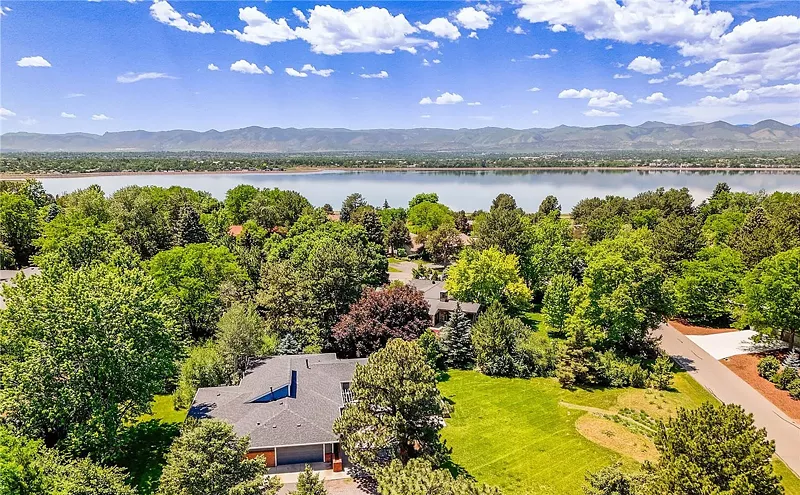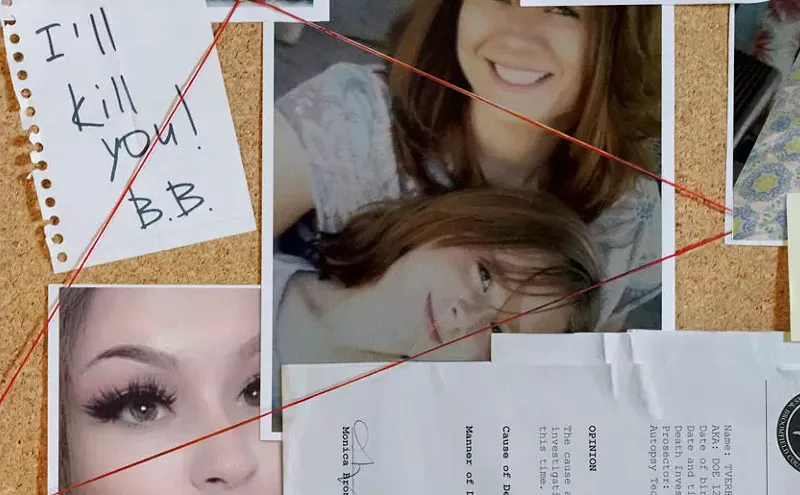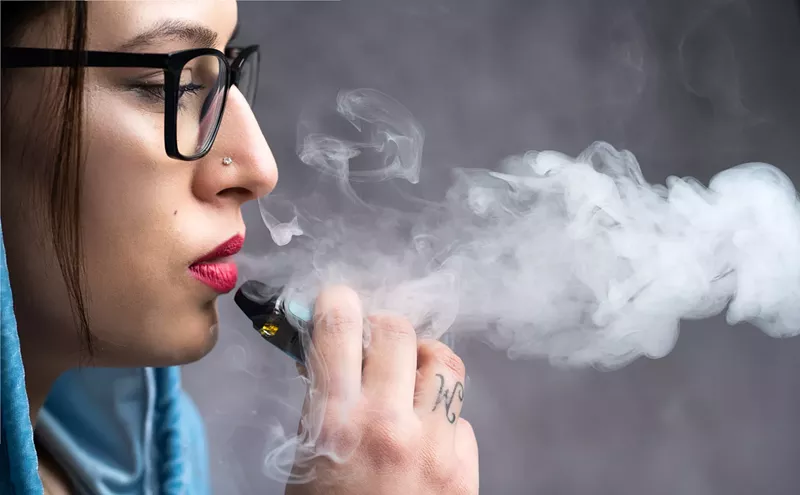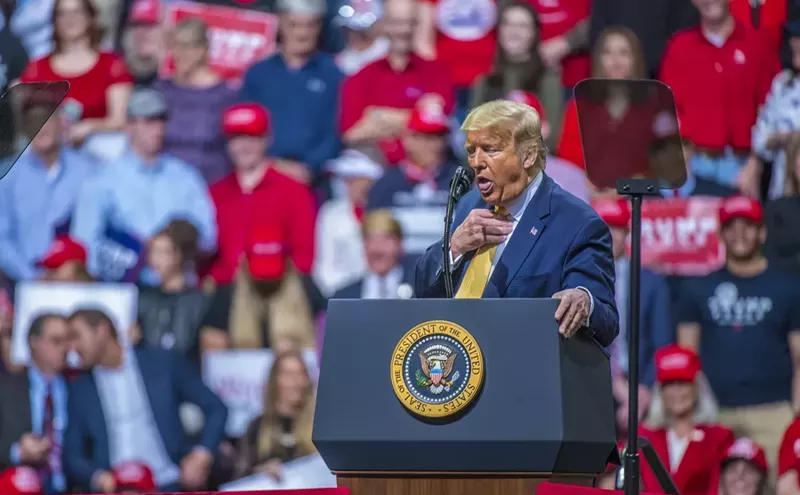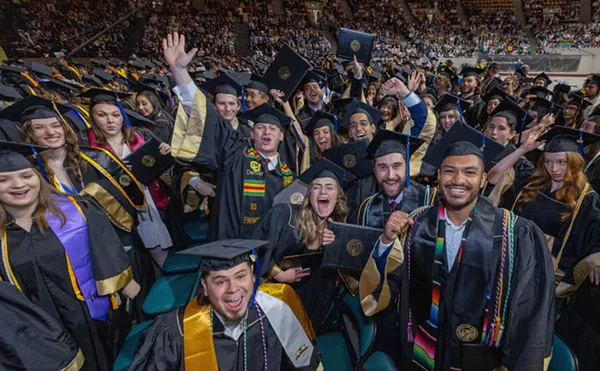Around 1 a.m. on June 3, law enforcement officers began dispersing the fifty or so individuals still by the State Capitol long after the end of the day's official protests and the start of the 9 p.m. curfew. Officers fired pepper balls at those remaining, and also deployed some type of projectile that emitted smoke.
Westword reached out to the Denver Police Department to find out what type of projectile this was, perhaps a smoke grenade or tear gas that qualify as "less-lethal force" allowed under DPD guidelines. Tamara Lenherr, a DPD spokesperson, responded that Denver police "did not use any [less-] lethal weapons during that night in question," but that there were "many other outside agencies helping the Denver Police Department with the protests."
Throughout the first week of protests in downtown Denver, it was clear that other law enforcement agencies were present; some had labels on their armored vehicles that revealed their affiliation. But what wasn't clear was just how many outside agencies were on hand...and the lack of coordination regarding what munitions were used, and when.
Officers from thirteen law enforcement agencies, as well as the Colorado National Guard, have been assisting the DPD during the protests over the death of George Floyd, which started in Denver on May 28.
"Each department that has assisted us during these protests has used their own less-lethal equipment. They follow their policy as to when they deploy different types of less-lethal options. Ultimately, the decision to use any of their less-lethal options is up to them," Lenherr says. So although the DPD is the lead in managing these protests, other agencies can decide which less-lethal munitions to use and when, even though they're outside their own jurisdictions.
Westword asked for a list of the munitions each outside agency has deployed; Lenherr says the department is compiling the information, but it will "be a long time until all that data will be collected."
The DPD itself has used pepper balls, pepper spray, tear gas, foam bullets and smoke grenades to disperse protesters, according to Jay Casillas, another DPD spokesperson.
Protesters, however, have repeatedly reported seeing flash-bang grenades being used by law enforcement. Asked about that on June 2, Casillas replied, "We have not used flash bangs. The loud noises were from fireworks that people used," implying that the loud noises that protesters heard came from the protesters themselves.
On May 29, Theresa Marchetta, director of strategic communications for the mayor's office, had admonished reporters on Twitter, writing, "FACTS: flash-bang devices, rubber bullets, rocks, bottles- NOT law enforcement. Uncover the truth."
She added that "the people destroying our city & inciting violence are NOT peaceful demonstrators or police officers. Investigate."
Westword did, and FACT: Protesters who said they saw flash-bang grenades were not mistaken. Even if the DPD didn't know it, outside law enforcement agencies have been using flash-bang devices at the Denver protests.
At the very least, deputies with the Adams County Sheriff's Office employed flash-bang grenades during the Denver protests, according to Paul Gregory, a spokesperson for the sheriff's office.
Asked about the Adams County officers' use of flash-bang grenades, Marchetta notes that her May 29 tweet referred to Denver police and shared "what was confirmed by Denver Police that night and confirmed by DPD’s Use of Force policy."
Westword has asked Adams County to determine when the flash-bang grenades were used, and has also reached out to all the other law enforcement agencies that have been assisting the DPD to determine which less-lethal munitions they have deployed.
At protests, it can be nearly impossible to identify the affiliation of law enforcement officers, especially when they're approaching people late at night while wielding paintball guns loaded with pepper balls. The officers, clad in armor used to quell riots, generally look the same. Some wear green uniforms, others blue, but there's no way to tell their original jurisdiction.
That becomes an issue for protesters, medics and media members at the demonstrations, since if someone believes they've been a victim of an inappropriate use of force, it's difficult to know where to complain. The DPD has been handling complaints regarding misconduct of its own officers, but complaints about other officers are being handled by law enforcement leadership in those jurisdictions. That's if the person who wants to file the complaint can even figure out where to go.
Adding to the confusion is the fact that each law enforcement agency is operating under its own use-of-force policy. So while Denver Police Chief Paul Pazen promotes Denver's policy as being a product of community engagement, many of the officers at the Denver protests don't have to abide by it; their jurisdictions have their own policies.
Both Pazen and Murphy Robinson, executive director of the Department of Public Safety, support Denver City Council's request to have the Office of the Independent Monitor, the city's law enforcement watchdog, conduct an "independent review of the Denver Police Department’s protocols and general allegations of misconduct."
In a joint letter to council on June 5, Pazen and Robinson note, "This has been an unprecedented event in our City. We believe it is important to thoroughly review and learn from these events to ensure we are partnering with and protecting the Denver community in the best way possible. We will work with the OIM to ensure that its review is thorough and complete."
But given the lack of coordination between law enforcement agencies, that review may have to go outside city boundaries...and perhaps even to federal court.
On June 5, Denver was hit by a class-action lawsuit from plaintiffs who claim that law enforcement treated them in an unconstitutional manner at the protests. Before a quickly called 6 p.m. hearing in federal court, the lead lawyer on the case, Milo Schwab, referred to the equipment used by police to disperse protesters as "incredible, excessive weapons." The lawsuit asks a judge to force the city to stop law enforcement from using less-lethal munitions against those at protests.
And late on June 5, Judge R. Brooke Jackson agreed, issuing a temporary restraining order against the use of "chemical weapons or projectiles of any kind against people engaging in peaceful protests or demonstrations" by law enforcement officers, except under special circumstances.
And the order is not just limited to the DPD, but all jurisdictions working with Denver. The RTO includes the stipulation that all non-Denver officers not use any demonstration of force or weapon beyond what Denver itself authorizes for its own officers.
Jackson acknowledges that law enforcement has a "very difficult and often thankless job," and notes that "the difficulty is in trying to draw an enforceable line that permits police officers to use appropriate means to respond to violence and destruction of property without crossing the line into the chilling of free speech and abusing those who wish to exercise it."
Here's the order:

Audio By Carbonatix
[
{
"name": "GPT - Billboard - Slot Inline - Content - Labeled - No Desktop",
"component": "23668565",
"insertPoint": "2",
"requiredCountToDisplay": "2"
},{
"name": "STN Player - Float - Mobile Only ",
"component": "23853568",
"insertPoint": "2",
"requiredCountToDisplay": "2"
},{
"name": "Editor Picks",
"component": "17242653",
"insertPoint": "4",
"requiredCountToDisplay": "1"
},{
"name": "Inline Links",
"component": "18838239",
"insertPoint": "8th",
"startingPoint": 8,
"requiredCountToDisplay": "7",
"maxInsertions": 25
},{
"name": "GPT - 2x Rectangles Desktop, Tower on Mobile - Labeled",
"component": "24956856",
"insertPoint": "8th",
"startingPoint": 8,
"requiredCountToDisplay": "7",
"maxInsertions": 25
},{
"name": "Inline Links",
"component": "18838239",
"insertPoint": "8th",
"startingPoint": 12,
"requiredCountToDisplay": "11",
"maxInsertions": 25
},{
"name": "GPT - Leaderboard to Tower - Slot Auto-select - Labeled",
"component": "17676724",
"insertPoint": "8th",
"startingPoint": 12,
"requiredCountToDisplay": "11",
"maxInsertions": 25
}
]



